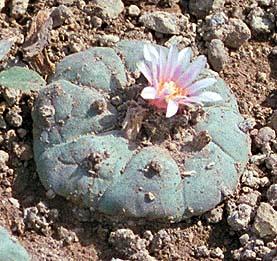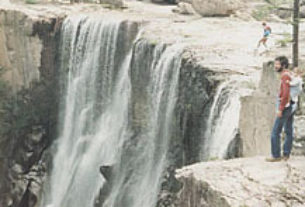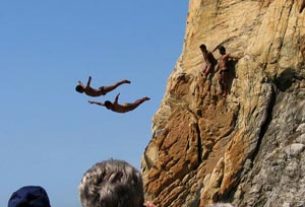Mexican History
Some years ago, Huichol art became very popular and was being sold at fabulous prices at exclusive boutiques around the world. On one occasion I helped my Huichol friends Nacho and his son-in-law Juventino sell some large yarn paintings. Shortly afterwards I was invited to attend the annual peyote fiesta at Las Guayabas, Nacho’s home pueblo in the Huichol Sierra.

The Peyote Fiesta takes place around the end of May or the beginning of June, the usual start of the rainy season in north-western Mexico. Still being an extranjero (foreigner) at the time, I was thinking in terms of North American time, not Huichol time. Anxiously I kept checking to see when we were going to leave for the peyote festival. But none of the Huichols around town were at all concerned about it. When I questioned a few of them selling their crafts at the Wednesday tianguis in Ajijic they assured me that it would very soon, any day now. I later learned that a lot of things depend on when the chief marakame (shaman-priest) dreams it is the auspicious moment for any action.
Departure
The day of departure finally arrived and my friends Kay, Pat, and I drove to Nacho’s rented adobe shack in Ajijic. Previously Nacho had told me he was going to leave most of his household belongings with a neighbour in nearby San Antonio Tlayacapan but, when we got to his house, we found that he had everything he owned piled up in a heap ready to go. Being “practical” ex-pats from north of the border, we were convinced that Kay’s old car and Pat’s small decrepit station wagon were simply not big enough to take everyone and everything. But we were not thinking like Huichols. After the luggage was somehow stored aboard the two vehicles, we began to load the passengers. There was Juventino, Nacho’s son-in-law, plus his 17-year-old wife, Sonya, their five-year-old baby son, Marilyn (one of Kay’s co-worker at Century 21), Pat, Nacho, his wife Leticia, their three children, and myself.
The Huichol gods must have been looking after us, for we arrived safely in Huejuquillo El Alto, at that time the end of the paved road into the Huichol Sierra. Beyond that lay a rough gravel road used by logging trucks and local merchants to reach the Huichol pueblo of San Andres, high on a plateau overlooking a profoundly deep canyon. At the bottom of the canyon lay Nacho’s home rancho. The women spent the night in the town’s only hotel, and I bunked in with the Huichols in their usual stopover place on the way home.
We left for San Andres the next day over a rough road through some of the most magnificent scenery imaginable. Not far out of San Andres, the gravel road took its toll and we had a ruptured gas tank to deal with. However, we did have the opportunity to visit the Franciscan Mission of Santa Clara, just off the road to San Andres. At that time this was one of the few Catholic missions still operating in that area. Dozens of excited, enthusiastic young Huichol boys, students at the mission, swarmed out to meet us but the priests held back the girls. We never got near the mission itself. But the position of the Catholic Church in the Huichol Sierra is another story.
We finally reached San Andres but there were no accommodations for visitors, so we stayed wherever our hosts could find a place for us in preparation for our descent down from the plateau of San Andres to Las Guayabas, the site of the Peyote Fiesta we were to attend.
Apart from the main centres, such as San Andres and Santa Catarina, the Huichols live in hundreds of small ranchos scattered throughout the sierras. Consequently the numerous fiestas of the Huichol religious calendar are held in different places around the same time but not, as I soon learned, according to any fixed time table.
Los Guayabos
After contemplating the three to four hour trek down the side of the San Andres plateau to the valley far below, the women decided to stay in San Andres and I went with the Huichols and their cargo, which include a foot pedal sewing machine.
I have been an avid runner all my life and thought I was in fairly good condition, until I started down that rocky slope with my backpack. The Huichol men carried much heavier loads and seemed to move effortlessly while I struggled to keep up. After an hour or so my thigh muscles felt like lead from the strain of putting on the brakes to avoid slipping on the loose stones on the narrow winding trail to the bottom. Somewhat chagrined, I looked over at Sonya carrying the baby. She appeared to be tripping along lightly, not even sliding on the stones the way I was. Eventually Juventino had to help me even with my smaller load. A humbling experience, but it revealed to me the hardiness and the strength of spirit that has enabled the Huichols to survive centuries of persecution in this remote, sometimes inhospitable region.
About half way down, Nacho, fearing that Sonya might slip with the baby, decided to summon help. He produced a curved cow-horn trumpet from his belt and blew several long blasts. We waited a few minutes. Then, seemingly out of nowhere several Huichols appeared, leading a mule. We loaded Sonya and the baby on the mule and resumed our journey to Nacho’s rancho.
Nacho had spent so much time in Jocotepec selling his crafts that he had not got around to building a house on his piece of land. That first night Nacho and his family slept in the calihuey (God House), a small round private temple with a thatched roof. The rest of us slept on raised reed platforms outside.
It was the end of the dry season and, up until then, there had not been a drop of rain for months. The Peyote Fiesta is also a time to pray for the return of the rains to nourish the maize and bean crops. The rain gods must have anticipated our arrival, for that night the roar of thunder was followed by a torrential rainstorm about two or three in the morning. Canvas sheets served as makeshift tents and we survived the night.
The next morning, Nacho emerged from the calihuey rubbing his stomach, an angry scowl on his face. There had been no time to clean out the calihuey after our arrival and a resident scorpion had stung him in the stomach. Different people react in different ways to scorpion stings but Nacho took no medication and after awhile seemed oblivious of the discomfort as he prepared for the ceremonies to follow.
Village life
Life in a Huichol rancho involves gathering wood, fetching water, tending to cattle and crops, and numerous religious fiestas, traditionally one for each month of the year. One of my tasks was to carry water from the spring some distance from the rancho. A small but rapidly flowing river cascades over the rocks near the dug well.
On one occasion I met an elderly man, back stooped, but still full of vigour with a youthful spring in his step. His pantalones were rolled up above his knees in the fashion of an earlier generation of Huichols and he wore the feathered sombrero of a shaman. I was unsure of the way back to the rancho, so he very kindly showed me the way. He gave me no reason to feel I was an intruder in Huichol territory.
Back at the rancho I sat on a rock near the calihuey. Huichols seem to spend a lot of time sitting on hard rocks without any show of discomfort.
Las Guayabas is situated on several levels. While I was sitting there, another Huichol came up the pathway toward Nacho’s place, his muvieries (sacred plumed arrows) tucked into the back of his embroidered sash. I later learned that this was Antonio Vincente, one of the head shamans.
At first I thought it was somewhat casual to carry sacred objects in one’s belt, but the Huichols simply think differently from us. Religion is such a part of their daily lives, at least for most traditional Huichols, that they do not make our distinction between the secular and the divine.
Antonio was getting ready for the ceremonies at a nearby rancho. He and Nacho sat under the shade of a brush lean-to and engaged in earnest conversation. Over in the distance I could see a group of dancers gathered in front of a large thatched roof building. The peculiar wailing sound of native violins and the occasional blast of a cow-horn trumpet drifted across to me.
I later learned that I was part of the topic of conversation between Nacho and Antonio. Nacho explained to Antonio that I was not just another gringo intruder. Antonio nodded his approval and I was at least partially accepted in the community.
We ate our lone meal of the day around a small fire over which the women heated tortillas. Apart from squash and a little fruit, the main course consisted of tortillas and raw chiles. Huichols eat very sparingly, especially during special fiestas. An outsider would starve on the Huichol diet.
Peyote Fiesta
After we ate, Nacho motioned me to follow him over to the distant fiesta already in progress.
Many people were gathered in front of the main building. On a bench to one side, some older Huichols — whom I judged to be community elders — sat resplendent in their best fiesta finery. Pots of stew were boiling over a large wood fire in front of the building. Various household utensils were set close by the fire while the women bustled around preparing the fiesta meal.
Facing the main building, the community centre or meeting hall, was a lean-to and a large maize cache on stilts. The women and children clustered around another, smaller building off to one side. I sat with Juventino and another Huichol whom I did not know under the shade of the cache.
It was then that I got my first indication that not all the Huichols at Las Guyabas welcomed me. I heard a pitter-patter beside me and turned to see several small pebbles rolling past me. I glanced up and saw several Huichol women sitting farther up the hill behind the cache. Since Huichol women seldom even speak to outsiders, male or female, I concluded that the gesture was not friendly. My impression was confirmed when the stranger beside us commented (in Spanish) that I, as a gringo, had no right to be at the Peyote Fiesta. I turned to Juventino and started talking about the yarn paintings we had sold together just before the start of the trip. The stranger then knew I was not there uninvited and he quickly moved off without another word.
The women and children remained more or less segregated from the men. Women’s Lib had not yet come to the Huichol Sierra, or so I thought until a very tall (for a Huichol) woman with yellow peyote symbols on her face offered me tejuino, a fermented maize beverage that takes five days to make. From her actions I concluded that she was a shamaness of some importance in the community.
Each person had his own mug and was served out of large metal buckets. Some of the men drank until they vomited and then they drank some more. Strangely enough no one seemed to get particularly drunk or in the least unruly. The drinking goes on much of the time and I was offered more and more tejuino. It would have been considered very discourteous not to accept the drink. Fortunately, I was able to pour out most of it very discretely behind the log on which I was sitting.
I knew I was accepted when the head shaman Antonio came over to me, led me over to the fire, and offered me tortillas and meat stew. Later we were handed small blue tamales to eat along with the tejuino.
I began to wonder where the peyote part of the fiesta came in because I had seen no sign of the hallucinogenic cactus and there was nothing in the tortillas but pure maize.
Nacho and Antonio sat on special chairs in front of the main building awaiting the approach of evening and the start of the main ceremony. I awaited the event along with the rest.
Part 5 of a seven part series
- Personal reminiscences of Mexico’s Huichol people I: a disappearing way of life?
- Personal reminiscences of Mexico’s Huichol people II: fiesta of medicinal plants
- Personal reminiscences of Mexico’s Huichol people III: the shaman
- Personal reminiscences of Mexico’s Huichol people IV: ritual dance
- Personal reminiscences of Mexico’s Huichol people V: journey to the sierra
- Personal reminiscences of Mexico’s Huichol people VI: Peyote Fiesta
- Personal reminiscences of Mexico’s Huichol people VII: return from the Huichol sierra


